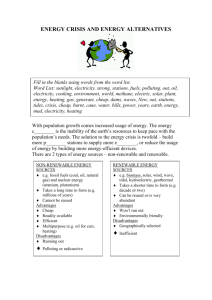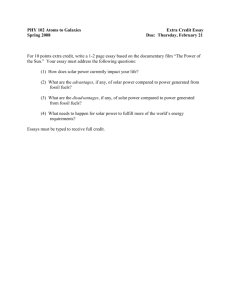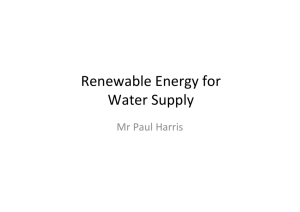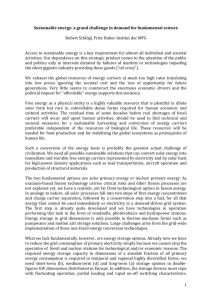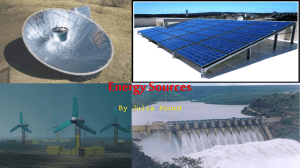energy sources - ghostnet surfers 2
advertisement
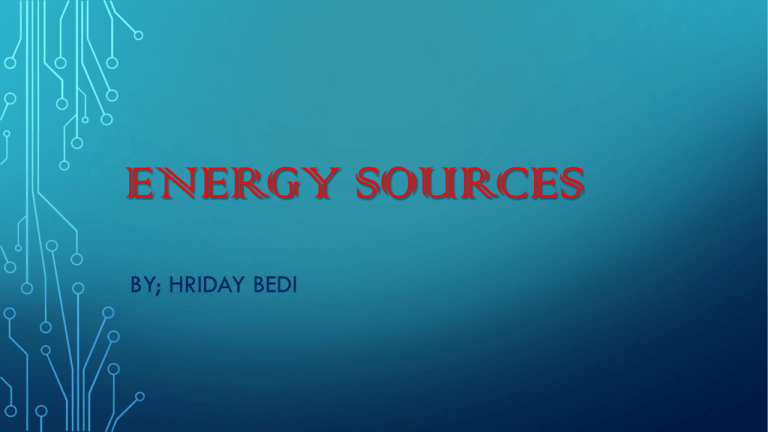
ENERGY SOURCES BY; HRIDAY BEDI NUCLEAR FUSION HOW IS IT CREATED? In nuclear physics, nuclear fusion is a nuclear reaction in which two or more atomic nuclei collide at a very high speed and join to form a new type of atomic nucleus. During this process, matter is not conserved because some of the matter of the fusing nuclei is converted to photons. ADVANTAGES AND DISADVANTAGES! Pros of nuclear fusion Clean energy. No greenhouse gases. Virtually limitless fuel available. (The deuterium can be distilled from seawater and the tritium can be “bred” in the reactor.) No chain reaction. Easier to control or stop than fission. Cons of nuclear fusion Commercial power plants would be extremely expensive to build Requires extremely high temperatures. Difficult to contain Could produce a net negative amount of energy WHERE AND HOW IS IT USED? No full scale production till 2050 Not in use yrt but being built in advanced research labs TIDAL ENERGY • HOW IS IT CREATED? • Tidal energy is a form of hydropower that converts the energy of the tides into electricity or other useful forms of power. The tide is created by the gravitational effect of the sun and the moon on the earth causing cyclical movement of the seas.] • • • • • • ADVANTAGES AND ADVANTAGES Advantages of Tidal Energy 1) It is an inexhaustible source of energy. 2) Tidal energy is environment friendly energy and doesn't produce greenhouse gases. 3) As 71% of Earth’s surface is covered by water, there is scope to generate this energy on large scale. Disadvantages of Tidal Energy 1) Cost of construction of tidal power plant is high. • 2) There are very few ideal locations for construction of plant and they too are localized to coastal regions only. • 3) Intensity of sea waves is unpredictable and there can be damage to power generation units. • WHERE IS IT USED? • Although not yet widely used, tidal power has potential for future electricity generation. WIND ENERGY • HOW IS IT CREATED? • Wind power or wind energy is the energy extracted from wind using wind turbines to produce electrical power, windmills for mechanical power, wind pumps for water pumping, or sails to propel ships. • ADVANTAGES AND DISADVANTAGES • Advantages of wind power: • 1. The wind is free and with modern technology it can be captured efficiently. • 2. Once the wind turbine is built the energy it produces does not cause green house gases or other pollutants. • 3. Although wind turbines can be very tall each takes up only a small plot of land. This means that the land below can still be used. This is especially the case in agricultural areas as farming can still continue. • DISADVANTAGES OF WIND POWER: • 1. The strength of the wind is not constant and it varies from zero to storm force. This means that wind turbines do not produce the same amount of electricity all the time. There will be times when they produce no electricity at all. • 2. Many people feel that the countryside should be left untouched, without these large structures being built. The landscape should left in its natural form for everyone to enjoy. • 3. Wind turbines are noisy. Each one can generate the same level of noise as a family car travelling at 70 mph. • WHERE IS IT USED WHO USES IT? • At open areas such as farms and is available for public use PARABOLIC REFLECTOR • HOW IS IT CREATED? • A parabolic reflector is a reflective surface used to collect or project energy such as light, sound, or radio waves. The parabolic reflector transforms an incoming plane wave traveling along the axis into a spherical wave converging toward the focus. Conversely, a spherical wave generated by a point source placed in the focus is reflected into a plane wave propagating as a collimated beam along the axis. • ADVANTAGES AND DISADVANTAGES? • Advantages: • The solar parabolic dish - stirling engine system can be used as a relatively small distributed power source, because a single unit is self-contained. By combining a lot of the units, MW levels of electricity from solar power can be produced. • The solar parabolic dish - stirling engine system has only a very minimal water requirement. The engine is air cooled, so no cooling water is needed and the performance penalty associated with dry air condenser cooling for a steam power plant doesn't enter into the picture. Disadvantage: Due to the distributed nature of the solar parabolic dish - stirling engine system, with many individual units, this type of system doesn't lend itself well for thermal energy storage, to allow electricity generation when the sun isn't shining. WHERE IS IT USED ? On large open fields available for public use.s SOLAR CELL • HOW IS IT CREATED? • A solar cell, or photovoltaic cell, is an electrical device that converts the energy of light directly into electricity by the photovoltaic effect. It is a form of photoelectric cell, defined as a device whose electrical characteristics, such as current, voltage, or resistance, vary when exposed to light. Solar cells are the building blocks of photovoltaic modules, otherwise known as solar panels. • ADVANTAGES AND DISADVANTAGES • Advantages • 1. Solar energy is free although there is a cost in the building of ‘collectors’ and other equipment required to convert solar energy into electricity or hot water. • 2. Solar energy does not cause pollution. However, solar collectors and other associated equipment / machines are manufactured in factories that in turn cause some pollution. • Disadvantages • 1. Solar energy can only be harnessed when it is daytime and sunny. 2. Solar collectors, panels and cells are relatively expensive to manufacture although prices are falling rapidly. • WHO USES IT WHERE IS IT? • They are on some buildings, open fields and on some shop for private use. FOSSIL FUEL. • • HOW IS IT CREATED? • • ADVANTAGES AND DISADVANTAGES Fossil fuel is a general term for buried combustible geologic deposits of organic materials, formed from decayed plants and animals that have been converted to crude oil, coal, natural gas, or heavy oils by exposure to heat and pressure in the earth's crust over hundreds of millions of years. Advantages of Fossil Fuels A major advantage of fossil fuels is their capacity to generate huge amounts of electricity in just a single location. Fossil fuels are very easy to find. The Disadvantages Of Fossil Fuels Release Greenhouse Gasses - Because fossil fuel contains hydrocarbon, it often releases greenhouse gasses like carbon dioxide and methane which can really provide great damage in the ozone layer. Serious Ecology Disasters - Aside from the greenhouse gasses it releases, it can also cause a serious disaster in the ecology. Many people and animals will surely be affected by it. WHO USES IT WHERE IS IT USED? Fossil fuels come from carbon-based organic materials that are many millions of years old. Using them to generate electricity produces greenhouse gases. Gas is often referred to as a 'cleaner energy source' because it can emit less than half the carbon emissions of coal. Its available for public use. HYDROELECTRICITY. • • HOW IS IT CREATED? Hydroelectricity is the term referring to electricity generated by hydropower; the production of electrical power through the use of the gravitational force of falling or flowing water. • ADVANTAGES AND DISADVANTAGES • Advantages • 1. Once a dam is constructed, electricity can be produced at a constant rate. • 2. If electricity is not needed, the sluice gates can be shut, stopping electricity generation. The water can be saved for use another time when electricity demand is high. • Disadvantages • 1. Dams are extremely expensive to build and must be built to a very high standard. • 2. The high cost of dam construction means that they must operate for many decades to become profitable. • WHERE IS IT WHO USES IT? • It comes from dams and is being used for decades for public use.

